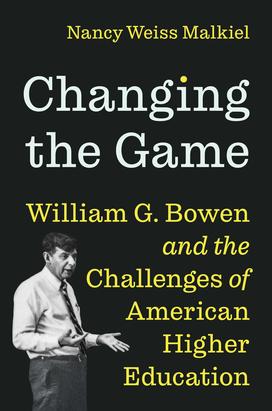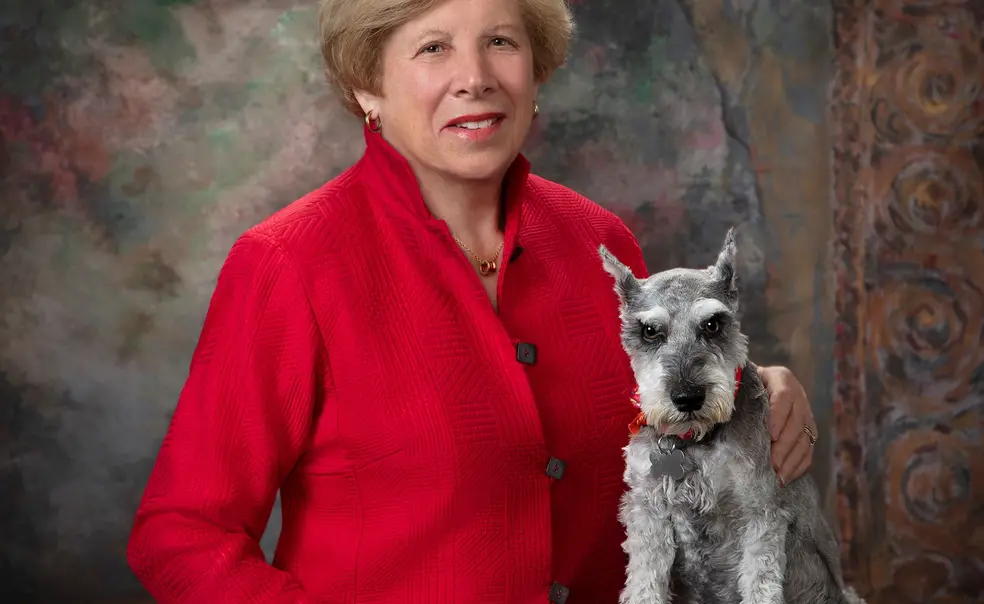Nancy Weiss Malkiel Honors William G. Bowen’s Impact on Princeton
The book: William G. Bowen (1933-2016) served as provost and president of Princeton University and later as president of the Andrew W. Mellon Foundation. Throughout his career he tackled some of the most complex, challenging issues in higher education including college access, affirmative action, and inclusion. In Changing the Game (Princeton University Press), Nancy Weiss Malkiel argues that Bowen’s leadership made him the most influential figure of his generation, and he ultimately played a major role in transforming both Princeton and Mellon into the institutions that they are today.

The author: Nancy Weiss Malkiel is a professor emeritus of history at Princeton, where she was the longest-serving dean of the college. A scholar in 20th century American history, Malkiel joined the faculty in 1969 and transferred to emeritus status in 2016. She’s the author of a number of books including Keep the Damned Women Out: The Struggle for Coeducation and Whitney M. Young, Jr., and the Struggle for Civil Rights. She earned her undergraduate degree from Smith College, and her master’s and Ph.D. from Harvard University.
Excerpt:
As provost (1967–72) and president (1972–88) of Princeton University and president of the Andrew W. Mellon Foundation (1988– 2006), and in the twenty books he authored, William G. Bowen confronted the central problems of American higher education. He tackled the critical issues of “cost disease,” inclusion, affirmative action, college access, college completion, online learning—all the big, thorny problems that held American colleges and universities in their thrall in the half century from Bowen’s assumption of administrative responsibility as provost at Princeton to his death in 2016. He took on the biggest challenges he could, and he attacked them with formidable tenacity, insight, and wisdom. It was not that he solved those problems—no one could—but through his efforts and pragmatic insights, they became more tractable, more malleable, more susceptible to solution than they had been before. Bowen’s long history of addressing these issues shows us how vision, strategy, and political and organizational savvy can enable leaders to deal with pressing problems and elevate the stature and efficacy of major institutions.
Bill Bowen was arguably the most consequential leader in American higher education in the late twentieth and early twenty first centuries. He had a vision for higher education and a strategy for accomplishing that vision—not out of an existing playbook, not modeled on other institutions, but the product of his own invention. As provost of Princeton, working in close concert with President Robert F. Goheen, drawing on his own political and organizational sense, benefiting from the scale and collegiality of the institution, he helped to craft a governance structure and a set of strategies to lessen the disruptions at Princeton during the period of intense tumult over race at home and the Vietnam War abroad that rocked so many colleges and universities. He pressed Goheen to embrace coeducation as critical to Princeton’s future; he contributed in numerous ways to The Education of Women at Princeton, Gardner Patterson’s highly analytical, data-driven study of the desirability and feasibility of coeducation; he worked to sell the proposal to admit undergraduate women to Princeton alumni; and once the trustees approved, he worked assiduously on the many details required to implement it successfully.
As president of Princeton, Bowen built on groundwork laid in the Goheen era and purposefully remade the university in multiple ways. His first priority, in his words, was “to increase the intellectual muscle of the faculty” through targeted recruiting and higher standards for external appointments and internal promotions. There was ample evidence of his success in raising the caliber of the faculty—Nobel prizes, elections to national academies, ability to go head to head with major universities in the United States and the United Kingdom in recruiting, evident growth in the intellectual stature of important departments.
Bowen’s other most important priority, he said, was making the student body more diverse and more inclusive—active recruitment of Black students, early efforts to recruit Hispanic and Asian American students, the embrace of equal access in admissions for women and men. Along with recruitment went efforts to refashion institutional structures to be more open and more welcoming to the students who were now enrolling. Those efforts manifested themselves in major changes in the operations of the university chapel, especially to make ceremonial convocations more ecumenical and more inclusive of students of many faiths. The efforts led also to a successful initiative to establish a Center for Jewish Life. They led to institutional support for the legal campaign to require the remaining all-male eating clubs to admit women. And they led, too, to the development of a residential college system to provide an intellectual, cultural, social, and recreational home base for the increasingly diverse student population at the university. The Princeton that William G. Bowen inherited in 1972 was still struggling to shake off its historical identity as a very good liberal arts college for Protestant boys of good social standing, mainly from the mid-Atlantic and southern states. The Princeton he turned over to his successor, Harold T. Shapiro, in 1988 was far more diverse with a far stronger faculty and now had vaulted into the ranks of the world’s great research universities.
Princeton was in no way typical of American colleges and universities. It was smaller than its closest peers among private universities. It offered instruction limited to the arts and sciences and engineering, eschewing the full range of professional schools usually found in American universities. It focused on undergraduate education and had a very small graduate school, which it grew slowly over time. It had a single faculty who taught both undergraduate and graduate students. But for all of its uniqueness, a close examination of the Princeton case illustrates how an effective leader can take hold of an important institution and move, step by step, to confront the obstacles standing in the way of progress and transform it—to modernize it, to take it from very good to outstanding, to turn it into one of the leading examples of its kind in American society.
Over the decades, Bowen steadily widened his field of vision. Originally focused on Princeton, he looked next to other elite private universities and liberal arts colleges—elite private universities because of his conviction that they carried outsize influence; liberal arts colleges because of his own formative experience at Denison. Later, he focused directly, both in his own scholarship and in the educational initiatives he promoted at ITHAKA, on public institutions. [SIC] even before he made that pivot, however, his scholarship—especially on affirmative action and college athletics—was broadly meaningful to the public sector.
Just as Bowen’s programmatic initiatives had a transformative effect on so many aspects of American higher education, so his scholarship in higher education pointed the way to using social science research to illuminate issues of central importance to colleges and universities. Explicating the cost structure and financial pressures on institutions of higher education was an important theme in his early publications.
With his books The Shape of the River, The Game of Life, Reclaiming the Game, Equity and Excellence in American Higher Education, Crossing the Finish Line, and Higher Education in the Digital Age, Bowen made fundamental contributions to policies and practices at colleges and universities, to federal policy concerning affirmative action, and to further scholarship by labor economists and students of higher education seeking to do more sophisticated analysis of the important issues he raised.
For all his impressive strengths as a leader in American higher education in the late twentieth and early twenty-first centuries, Bill Bowen was certainly not alone in his efforts to make the academy more effective. Still, [he] stood out because of the range of his activity and impact: He played the key role in remaking Princeton into a university of the first rank; he led a major foundation in launching influential ventures for the public good; and he undertook scholarship grounded in voluminous new data not just to comment on aspects of higher education but to support fundamental changes in the ways colleges and universities did their most important work.
At a time when presidents, provosts, deans, and trustees of educational institutions have been struggling with major crises caused by the COVID pandemic, racial and social unrest, cultural conflicts, and economic challenges, Bowen’s example provides important guidance. Effective navigation of institutional crises, as this book shows, begins with a vision. It then combines vision with strategy— detailed, thoughtfully worked out, deliberately conceived to address the challenges at hand. It requires leadership—intelligent, forward-looking, steady, even inspirational—leadership capable of galvanizing the many constituencies so crucial to institutions. And it requires the courage to address the toughest problems, no matter how and where they present themselves and how difficult they are to ameliorate. Reminding ourselves of the Bowen example provides a playbook for addressing the pressing institutional crises of this third decade of the twenty-first century.
Excerpted from Changing the Game: William G Bowen and the Challenges of American Higher Education © 2023 by Nancy Malkiel. Reprinted by permission of Princeton University Press.
Reviews:
“Malkiel captures Bowen perfectly. An honest appraisal of a remarkable man.” — Lawrence S. Bacow, president emeritus of Harvard University
“Malkiel’s biography is a captivating and detailed account of William Bowen’s remarkable impact on the higher education landscape. Malkiel doesn’t shy away from the controversies, even as she makes a compelling argument for why Bowen is the most influential leader and scholar of higher education in the last fifty years.” — Jennifer Morton ’02, author of Moving Up Without Losing Your Way











No responses yet